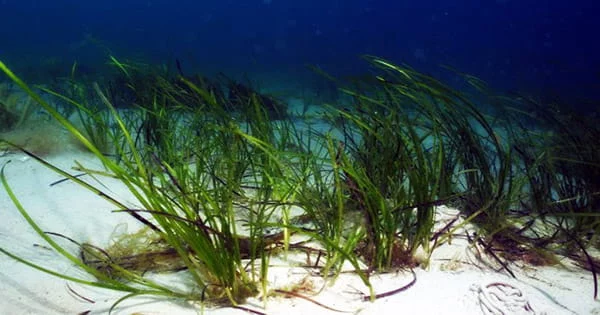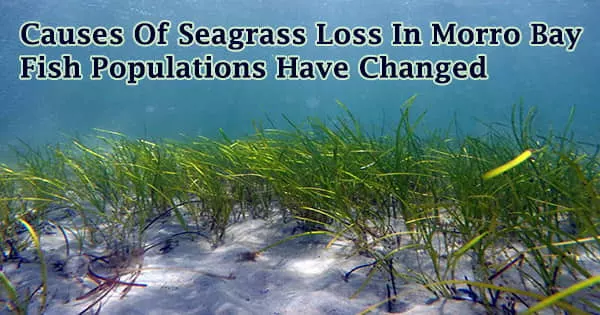In Morro Bay, the loss of seagrass habitat resulted in a drastic shift in fish species. According to an article published in the October 2021 print edition of Estuaries and Coasts by Cal Poly researchers, areas formerly covered in luxuriant seagrass meadows and distinct fish species are now home to muddy-seafloor-loving flatfish.
Seagrass meadows were formerly abundant across the Morro Bay estuary, but they have practically vanished in the last decade.
“Seagrass, like the eelgrass in Morro Bay, is important because it supports a range of marine life,” said Jennifer O’Leary, who led the research as a California Sea Grant extension specialist based at Cal Poly. O’Leary is now the Western Indian Ocean coordinator for the Wildlife Conservation Society. “It’s like the trees in a forest these underwater plants provide food, structure, and shelter to many of the marine animals that live in the bay.”

Underwater seagrass meadows are one of the most ecologically productive biomes on the world, and they are one of the most common habitats in coastal estuaries. Seagrass ecosystems, on the other hand, are disappearing at an alarming rate, rivaling that of tropical rainforests, coral reefs, and mangroves. Seagrasses are referred to be “coastal canaries” since their loss is frequently an indication of a greater issue. Their decrease indicates significant biodiversity losses and frequently has an impact on the communities that rely on them.
The relatively sudden and near complete collapse of eelgrass in Morro Bay has not only changed fish populations, but it has also resulted in substantial changes to estuary physics and geomorphology.
Ryan Walter
The seagrass ecosystem in Morro Bay, one of 28 estuaries identified by the US Environmental Protection Agency as essential to the nation’s economic and environmental health, has declined dramatically. Seagrass at this location, which was once dominated by a common California eelgrass (Zostera marina), has fallen by more than 95 percent, from 344 acres in 2007 to less than 15 acres in 2017.
Seagrass meadows are a multifunctional environment that provides food, shelter, and a nursery for a variety of fish and invertebrates, as well as securing sediments with their root systems. Seagrass meadows are frequently replaced with a less active, muddy bottom environment when they are destroyed.
Seagrass loss, according to O’Leary and colleagues, did not result in fewer fish, but rather changed the species of fish that reside in the bay. Some seagrass-specialist fish species, such as the bay pipefish, were seen to be declining in numbers by the study team (Syngnathus leptorhynchus). Bay pipefish have evolved to lurk amid the seagrass blades, with long thin bodies and olive green colors.
Flatfishes like the speckled sanddab (Citharichthys stigmaeus) and staghorn sculpin, on the other hand, have increased in number (Leptocottus armatus). These flat-bodied fish are prevalent in California bays and estuaries, where their flat bodies are suitable for living on the muddy bottom. These fish have taken over the traditional eelgrass habitats and now make up the bulk of Morro Bay’s fish species.
The decline of eelgrass habitat along the California coast poses a greater threat to seagrass-dependent species such as the bay pipefish. If seagrass does not rebound, the remaining meadows will be wider apart and their distribution will be more fractured, or spotty.
Because of the distance and patchiness of habitat, specialists like pipefish may be hampered in their capacity to relocate to a new area in search of food or mates. The genetic structure and diversity of the total pipefish population may be altered as a result of this community isolation over time.
“The relatively sudden and near complete collapse of eelgrass in Morro Bay has not only changed fish populations, but it has also resulted in substantial changes to estuary physics and geomorphology,” said study co-author Ryan Walter, a Cal Poly physics professor who has been studying eelgrass loss through a California Sea Grant-funded research project that was launched in 2018.
Walter, O’Leary, and other Cal Poly researchers are continuing to investigate the cause and implications of the eelgrass loss in collaboration with the Morro Bay National Estuary Program. The researchers recently discovered that the loss of eelgrass in Morro Bay resulted in extensive erosion, or sediment loss, throughout the estuary in another study.
The new study adds to what scientists already know about Morro Bay’s changes, and it might influence how scientists learn about seagrass habitats across California. Morro Bay is a unique occurrence that may help forecast future estuarine change because there has never been an eelgrass reduction of this size on the US Pacific Coast.
According to the experts, a multimodal approach to protecting and enhancing the surviving seagrass will be necessary. The remnant eelgrass is steadily spreading due to protection and local planting activities, including successful transplant operations conducted by the Morro Bay National Estuary Program. There is hope for the future.
Drone-based surveys were utilized by Walter and O’Leary to document natural eelgrass proliferation and regeneration in locations where it had been gone. In 2017, Morro Bay had just 9.4 acres of seagrass left; by 2019, it had grown to 36.7 acres. The researchers are currently evaluating data from 2020, but they are hopeful that seagrass acreage will continue to grow steadily.





